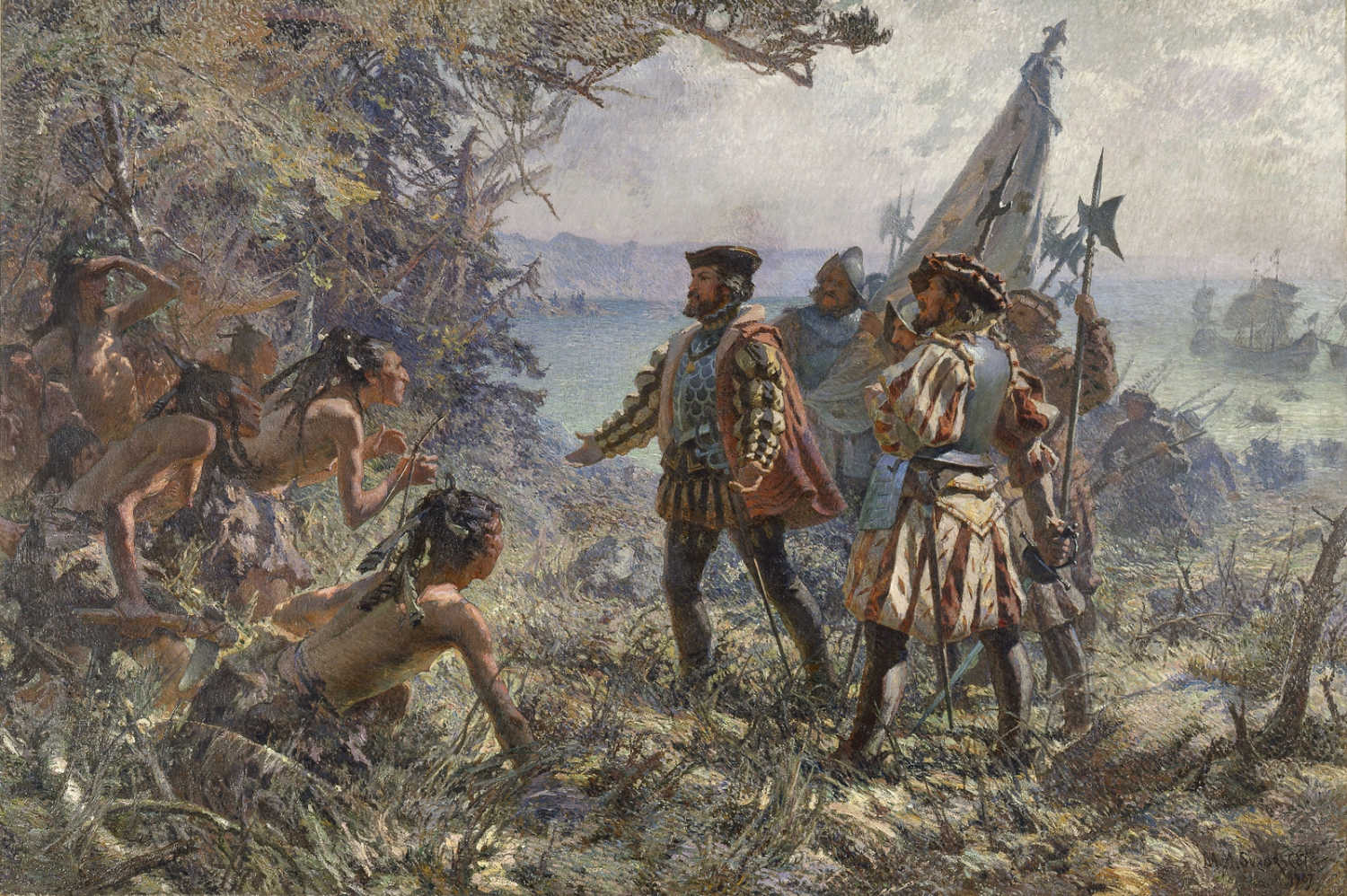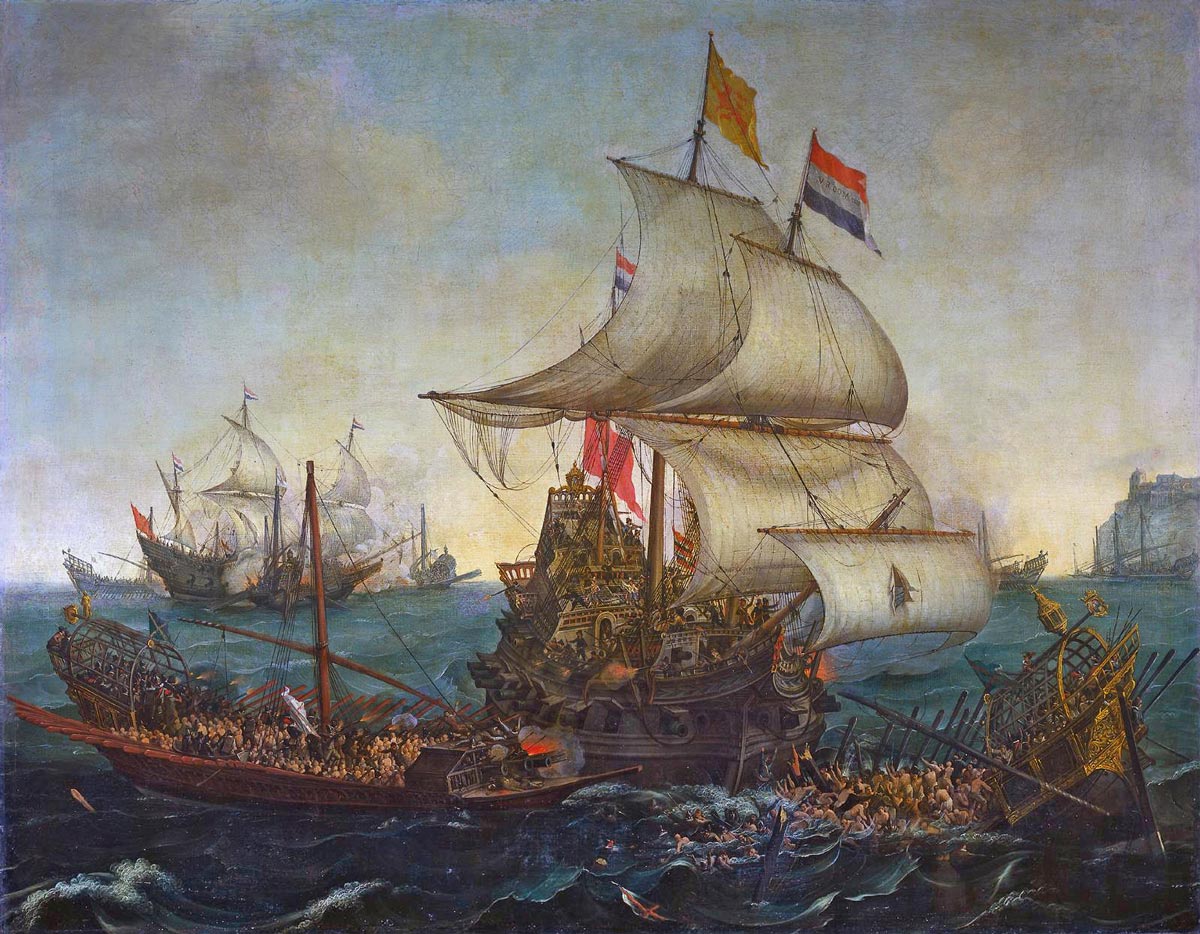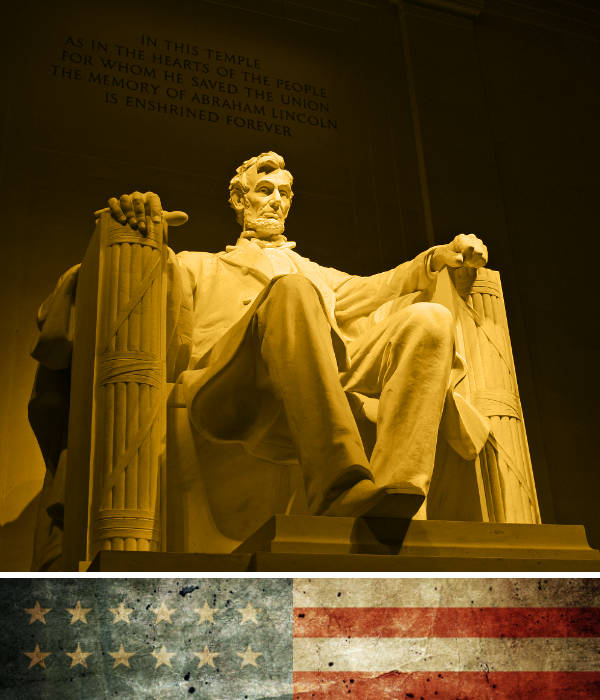New world order
The struggle for mastery by Europe

Show me the clause in Adam’s will by which he divided the world between my brothers of Spain and Portugal.
Francis I of France
In 1523 three Spanish galleons, heavily-laden with gold, silver, and other treasures plundered from the Aztec emperor Moctezuma, were themselves waylaid off the coast of Portugal by five vessels under the command of French naval captain Jean Fleury. Fleury gave chase, capturing two of the galleons, and with them an enormous haul of gold bullion and precious stones, pearls, jade, artworks and exotic animals en route to the Spanish King Charles V: instead they made a fine tribute to the French monarch Francis I.
This was one of the earliest and most successful acts of piracy against the fledgling Spanish empire, but despite Spain’s prompt fortification of bases throughout the Caribbean it was far from the last. Fleury himself captured many more Spanish and Portuguese vessels before the Spanish caught up with him and had him hanged in Toledo in 1527, but in his wake came wave after wave of English pirates, French corsairs and Dutch Watergeuzen (sea beggars). As the seemingly bottomless well of riches Spain had discovered in the Americas began to tip the scales in the struggle for mastery in Europe, her Old World rivals determined to take the contest to New World battlefields.
Gold heists aside though, Spain's neighbours entertained far more modest ambitions. At the behest of the English King Henry VII, Italian navigator Giovanni Caboto became the first European to set foot on North American soil since the Vikings in 1497. He'd made the far shorter northern crossing in Leif Erikson's wake, on a mission to to find, discover and investigate whatsoever islands, countries, regions or provinces of heathens and infidels, in whatsoever part of the world placed, which before this time were unknown to all Christians
. They made landfall somewhere on 24th June, pottered around a little, raised the banners of Venice and the Pope, claimed more or less everything for the King of England and the Catholic Church, and then sailed on up the coast and back to England. Henry gave Cabot £10 for his trouble. Cabot made another crossing the following year, from which no-one returned (maybe - if they did, they certainly didn't make a big deal out of it). There were a few further explorations from Bristol, but Henry's successor (Henry VIII) had little interest in the matter and there was no further English exploration until the Elizabethan pirates and explorers pursued their proxy war with Spain from the 1560s.
Francis I of France, though largely devoted to waging war against Charles V in Europe and the Mediterranean, despatched Italian seaman Giovanni da Verrazzano to explore the eastern seaboard of the newfoundland to the north for a route to the Pacific , and later Jacques Cartier to 'discover certain islands and lands where it is said that a great quantity of gold and other precious things are to be found'. Cartier made three voyages to the Gulf of St Lawrence between 1534 and 1542, and it was he who named these territories Canada, derived from a mistranslation of the native Huron and Iriquois word 'kanata', meaning village. The French made various attempts to start colonies, all thwarted by the severe weather, scurvy and disease, and by the hostility of numerous native American tribes, and maintained nothing more than seasonal trading posts in the cold and less hospitable north. The plentiful fish stocks and thick furs of the larger mammals (such as beavers, foxes and otters) were in high demand in Europe, and easily tradable for cheap manufactured goods like knives, kettles and beads.
To pass by and eye is no title of possession.
Francis I of France
The death of French King Henry II in 1559, then that of his 15-year-old son Francis II in 1560 and the ensuing Wars of Religion, eliminated the possibility of any serious French challenge to Spain's position in the New World for the remainder of the sixteenth century. There was an attempted colony in Rio de Janeiro, France Antarctique, dislodged by the Portuguese, and the short-lived town of Charlesfort built on an island off the coast of South Carolina in 1562. Charlesfort (named for Charles IX of France, who had succeeded Francis in 1560) was founded Jean robault, an explorer sent by the great Huguenot (French Protestants) Admiral Gaspard de Coligny. When hostilities broke out between Catholic and Protestants in France in 1562 however the colony was left to fend for itself - most of the settlers opted to build their own vessel and sail unguided back across the Atlantic, with shirts for sails and shoes for food (garnished, when the going got tough, with one of their unfortunate comrades). Rescued by an English ship and ferried back to London, they spun unlikely tales of the wonders of Florida, of precious metals and spices, and of precious jewels so abundant and dazzling they could only be mined after dark.
René Goulaine de Laudonnière founded a successor colony, Fort Caroline, in Florida in 1564, but again resupply was hampered by the wars in France, driving them to conflict with native tribes and attacks on Spanish shipping from the Caribbean. Spain duly despatched a fleet to remove this irritant, and the French sent their own led by Jean Ribault to relieve the settlement. The French had the better of an initial skirmish, forcing the Spanish to retreat, and land on the Florida coast, where they built a small settlement named St Agustin, in honour of the feast day of St Augustine on which they had made landfall. The pursuing French fleet was scattered and largely destroyed by a huge hurricane, wherupon the Spanish marched north and surprised Fort Caroline, destroying the fort and massacring most of the settlers. Many survivors of Ribault's fleet who surrendered to the Spanish forces were also slain, though some who professed to be Catholics were spared. As Kenneth Davies summed up, the first encounter between European Christians in America ended in a blood bath
. The Spanish built their own fort on the Caroline site, which met a similar fate at the hands of a vengeful French fleet in 1568, whereupon the site was abandoned. St Augustine endured, and today remains the oldest continuously-occupied European settlement, and there, in 1566, Martín de Argüelles became the first European to be born in the continental United States.

The sixteenth and seventeenth centuries were Spain’s literal and metaphorical Golden Age, build in large part upon their New World bonanza. Within a few decades of exploration and conquest the Spanish built an empire greater than Rome's. Ferdinand and Isabella married their daughters well, into the English and Portuguese royal lineages, and their daughter Joanna the Mad's marriage to Philip the Fair in 1506 brought his inheritance of the Burgandian Netherlands as well as his claim to his father's title of Holy Roman Emperor (the secular equivalent of the Pope, temporal heir to the throne of Charlemagne). Their grandson, Charles V (1516-56), was the true heir to these astute dynastic policies, ruling over lands in Italy, Germany, Austria and the Low Countries, as well as Spain and the Americas, and from 1519 he became Holy Roman Emperor too.
As the first ruler to unite the crowns of Aragon, Castille and León, Charles V is also known as Charles I, first King of Spain, though until later life he had a merely indifferent grasp of Spanish, having spent his boyhood in the Low Countries, and he was widely viewed as a foreigner in Spain itself. Nevertheless he made Spain the preeminent power in Europe, and the world, and the global leader of Christendom (the sack of Rome by Spanish troops in 1527 helped clarify the precise balance of power with the Papacy) - there were wars against the French in Italy, and against German Protestants, as well as against the Ottomans in the Mediterranean, and countless rebellions, but Spain remained paramount: it was Charles' refusal to countenance a Papal dispensation to allow Henry VIII of England to divorce his aunt, Catherine of Aragon, that set England on the path to its Protestant Reformation. In 1554 Charles' son and, from 1556, successor, Philip II, was even King of England too, as husband to Mary I (daughter of Catherine and Henry VIII): had Mary bore an heir from this union before her death in 1558, the throne of England could have been added to this vast empire, and the history of Europe and the Americas might have turned out very differently. Nevertheless Spain's domination was sufficient to enforce a near-total monopoly on the New World, save only Portuguese settlements in Brazilian territories east of the Tordesillas Meridian, but in 1581 Charles' son Philip II assumed the Portuguese crown too, uniting the two nations until 1640.

Such was Spain's primacy that when newly-Protestant England, and its excommunicate Queen, Elizabeth I, was driven to war in 1585, it was an undeclared one, fought by proxy in the Netherlands and the Americas where privateers had long preyed on the Spanish treasure ships. The most famous of England’s seadogs was Sir Francis Drake, who sailed around the world in 1577-80: Drake captured and plundered the settlements at Santo Somingo and St Augustine in 1586, and in 1587 went one better, ‘singing the King of Spain’s beard’ by looting the Spanish port of Cadiz. He then played a leading role in the defeat of the Spanish Armada in 1588, a decisive engagement in the future of the Americas, for it saved England from invasion, and likely Spanish conquest. Still, Elizabethan England could do nothing more than pick at the edges of Spanish hegemony, harrying her shipping and aiding her foes, but never strong enough to challenge Spain directly. Yet it was not in war but peace that England was to be a greater threat. Caribbean piracy was
, as Hugh Brogan wrote, holy, lucrative, and for a long time easy
, but after the Treaty of London in 1604 ended the Anglo-Spanish war, and that particular source of profit, English eyes were forced looked further, to the riskier but richer rewards of a more long-term American strategy.
It has only been from accident and the unacountable mismanagement of the Spaniards that any of the nations of Europe worth looking after have been left in a condition to preserve their liberty.
William Paterson, first Governor of the Bank of England, 1701
Bibliography
- Brogan, H. (2001) The Penguin History of the United States of America (2nd ed.), London, Penguin.
- Hakim, J. (2003) The First Americans, Prehistory - 1600 (3rd ed.). New York, Oxford University Press.
- McGrath, J. (1997). A Massacre Revised: Matanzas, 1565. Proceedings of the Meeting of the French Colonial Historical Society, 21, 15-29.
- Taylor, A. (2013) Colonial America: A Very Short Introduction. Oxford, Oxford University Press.

